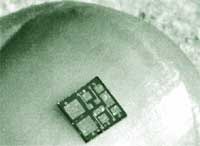 Heavily chipped
Heavily chipped
A study led by Eric Williams and his team at the United Nations University in Tokyo has
found that a 2 gramme microchip is equivalent to 1.6 kilogrammes of fossil fuel, 72
grammes of chemicals and 32 kilogrammes of water. Looking into all the chemicals including
coal, which are involved in turning raw quartz into a 32 MB RAM microchip, the team found
the chip manufacturing required more fuels and solvents because of its tiny size and the
need to keep it free from dirt and dust. Making a typical car required only about twice
its weight in fossil fuels. According to Eric Williams, "In order to produce one
memory chip that weighs two grams, the total amount of materials and fossil fuels required
to make that chip is 1,400 grams. That’s 700 times the weight of the original
chip." The environmental costs of manufacturing a chip thus far outweigh that of even
making a car. With new advances in technology and changing of computers every two years,
the environmental impact of owning a computer increases drastically.The focus now has to
shift from making chips that run on less power to manufacturing those that require less
energy than it does at the present.
Mercurial tempers
Each mercury fever thermometer when broken or thrown away is a threat to health. The
one-gram of mercury found in one thermometer is enough to pollute a 20-acre lake, says
Michael Bender, Director of the Mercury Policy Project, USA.
Mercury is used in lamps, batteries and electrical equipment, as well
as in thermometers and dental fillings. Concern over its presence in the atmosphere arises
since mercury is known to cause permanent damage to the brain, nervous system and kidneys.
Almost indestructible, mercury when put along with other waste into landfill sites, can
easily seep through the groundwater and from there into rivers, lakes and the sea. It can
also evaporate into the air, especially if the waste is incinerated.
Though mercury is produced naturally in rocks, soil and volcanoes,
industrialisation has boosted up the production of this heavy metal almost three times.
Almost 50 to 70 per cent of the 5,000 to 10,000 tonnes of mercury found in the atmosphere
is due to human activities. In its evaporated form, mercury can travel for thousands of
miles. Since it is know to accumulate in cold places high contamination levels of mercury
are to be found in Arctic regions, and especially among fish and animals there. In water,
mercury transforms naturally into methyl mercury, a highly toxic compound that gets
absorbed by humans and animals. Because it then accumulates up the food chain sea fishes
can accumulate large quantities of mercury in their tissue. Pregnant mothers and their
fetuses are particularly sensitive to the effects of mercury. According to the Centres for
Disease Control (CDC), Atlanta, USA, one-in-ten women of childbearing age have mercury
levels in their bodies above what is considered protective for a developing fetus.
 Threatened children
Threatened children
A study conducted by Joseph Laquatra, associate professor of design and environmental
analysis in the New York State College of Human Ecology at Cornell, in the US, has found
children belonging to lower socio-economic status more prone to threats from indoor air
pollutants. Their houses have higher levels of radon, lead and mould than those occupied
by higher income households. If these children then spend the rest of the day exposed to
the same pollutants in a childcare facility, they are at a significantly higher risk for
falling sick due to lead poisoning, cancer, asthma attacks and allergies. Studying 328
houses and 75 childcare facilities in six nonmetropolitan counties of New York State,
homes of lower income residents were also found to contain higher levels of carbon
monoxide. Lack of an effective ventilation fan further aggravates the pollutant level.
These houses also had asbestos problems and presence of basement mould. Mould is a known
trigger for allergies and asthma. Exposure to lead, asbestos, radon and carbon monoxide
can lead to early death.
Cancer clusters
Factors like where a woman lives at birth and puberty may have an impact on her risk of
developing breast cancer later. A study conducted by Jo Freudenheim, professor in the
department of social and preventive medicine in the University of Buffalo’s school of
medicine and biomedical sciences, USA, finds that women who developed breast cancer were
more likely to have lived closer together at birth and at their first menstruation than
women who did not develop breast cancer. This suggests a possible linkage between breast
cancer and early environmental exposure to potential carcinogens.
Identifying these places and exposures is one way of proving these
linkages. In that respect, geographers and epidemiologists are working on a computerised
mapping programme wherein details about residential data along with the distance between
the surrounding environment comprising of steel mills, chemical factories, petrol pumps
and toxic waste sites that have been in the existence between the two counties between
1918-1980 will be weighed against with the birth and menarche details of the women. This
information will then be compared for women with or without cancer. Early data collected
and calculated reveals the greatest clustering of cancer cases at the time of menarche.
This could be because breast tissue may be more sensitive to environmental insults in
childhood and that exposures early in life could increase the risk of breast cancer in
adulthood.

